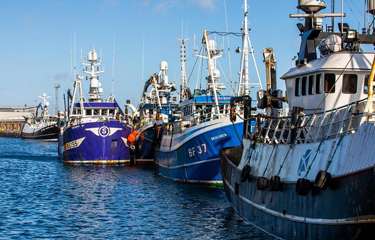Peru’s Ministry of Production (PRODUCE) has established a quota of 2.51 million metric tons (MT) for the upcoming anchovy fishing season in the country’s north-central zone.
The country divides its anchovy fishing areas into two regions – south and north-central – with different capture limits and seasons set for each one. The north-central is Peru’s main fishing region. The total biomass of the north-central zone’s stock amounts to 9.88 million MT, but the size composition is made up of both juveniles and adults from two to 18 centimeters in length, PRODUCE Minister José Luis Chicoma said in a release, basing his observations on findings from the Peruvian Sea Institute (Imarpe) – a specialized technical agency within PRODUCE which advises the state on marine conservation issues.
"This mixture of juvenile specimens with those suitable for capture are at levels that require monitoring to strengthen management and conservation measures," Chicoma said.
As such, PRODUCE has authorized exploratory fishing for 10 days in order to update the information on the distribution and size of the anchovy biomass, in order to adopt measures such as the partial or total closure of areas or protect the group of juveniles. The fishing season is to begin once the exploratory fishing is completed.
For 2020, Peru’s anchovy landings reached 4.31 million MT, 27.6 percent higher than in 2019, with exports valued at USD 1.28 billion (EUR 1.06 billion), despite the COVID-19 pandemic.
Enrico Bachis, the market research director for IFFO – The Marine Ingredients Organization, said expectations were for a quota of 2.5 million to 2.8 million MT.
“I would say the quota was probably in line with expectations,” he told SeafoodSource. “It’s great news because it shows the anchovy biomass is really well-managed – that it’s a very sustainable fishery. It shows that the fish are there, the biomass is there – that we can basically continue to produce large amounts of fishmeal and fish oil from the anchovy coming from Peru, which provides 20 percent of global supply. The market is relaxed now. The first half of the year should be another good year for the industry and if the second half of the year is as expected, we should be able to produce five million MT of fishmeal and one million MT of fish oil, in line with our projections. That will keep market happy.”
Prices have held steady despite the disruptions to the supply chain caused by COVID-19, according to Bachis.
“We are exactly where we were last year, at around USD 1,500 [EUR 1,238] per metric ton of fishmeal,” he said. “When you have stable supply like we’ve had for the last three years, the market is happy, and you see lateral prices for this amount of supply. It shows feed producers are really capable of producing with this amount finite of fishmeal and fish oil. Obviously, we had some fluctuations during the year, because sometimes people were speculating – especially in China – and sometimes due to the setting of quotas, but overall, it has been stable prices.”
Stable volumes helped solidify a market that faced unprecedented challenges this year, including a shutdown of the global foodservice sector, a tightening of China’s imports inspection regime, logistical complications caused by interrupted transportation flows, and production challenges caused by heightened safety protocols at processing plants, according to Bachis.
“There were a lot of concerns,” he said. “But in the end, there were adjustments made … and then everything came to order.”
Long-term, Bachis said he wonders whether consumers will continue to cook more seafood at home or whether they’ll slide back into their old preference for consuming it primarily in restaurants. But he said with fishmeal demand and prices remaining steady between 2019 and 2020, it shows the market is “really mature.”
“Everyone now knows the biomasses will be managed in a sustainable way and that the supply side shouldn’t see too many surprises in the future, unless environmental conditions change,” Bachis said. “We are in a lucky period because we haven’t seen any El Niño or La Niña [effects] for some time, and supply has been stable. If we start to see more of El Niño or La Niña, that will create more disturbances to the market. Clouds will eventually come, we know, because this is a cyclical industry … [but] demand is there and over the next five to 10 years, we are pretty confident it will be there, and the market also knows the quality of marine ingredient products, so the market is pretty relaxed now.”
Cayetana Aljovín, president of Peru’s National Fisheries Society (SNP), which represents the country's commercial fishing industry, said previously Peru’s anchovy capture limits for 2021 will be similar to those of 2020 if the biomass remains stable, meaning a total of some 5 million metric tons (MT) of fishmeal and 1.2 million MT of fish oil.
But Aljovín cautioned that the 11 April national elections, which included a presidential contest and voter decisions on all 130 seats of Peru’s unicameral congress, could affect the fishing sector’s productivity. In the April elections for president, the left-wing Free Peru party’s Pedro Castillo – a school teacher and union organizer from Cajamarca who has called for the nationalization of companies in industrial sectors deemed key to the national strategic interest – received the most votes in the first round, at 19 percent. He will now face a run-off election on 6 June against Keiko Fujimori, a congresswoman and leader of the right-wing Popular Force, who garnered just over 13 percent of the vote. Keiko Fujimori is th daughter of Alberto Fujimori, the president of Peru from 1990 until he resigned in 2000 after being accused of corruption and human rights abuses. He is currently serving a jail sentence in Peru.
Photo courtesy of Karen Murray/IFFO







